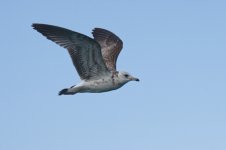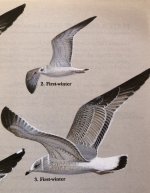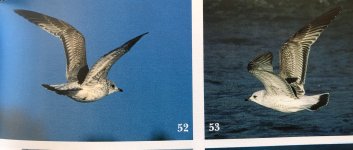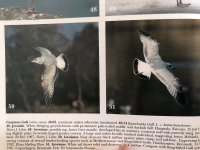
Hello all,
We went on a pelagic trip off the coast of northern Tuscany last week, and among the birds we saw there was the gull below, which we took as a 1st winter Common Gull, as it was thus identified by the guy who organised the trip. We usually don't see many Common Gulls in Italy. They do winter here, but we don't often go to places where they do. We are familiar with summer plumage adults as we have seen them often in northern Europe, but, living halfway up a mountain, we are not very good at gulls' moults in general, so we relied on the identification that was made for us.
MKinHK observed the heavish bill and the very dark collar and we subsequently looked it up in the Olsen-Larsson book, noticing what he meant about the bill, and the collar.
I am also attaching below pics from the above book. Captions for photo 52 says "1st winter, underwing coverts and axillaries normally with rather prominent dark tips". 53 says "1st winter heinei, Normally inseparable from canus, this bird shows narrower dark underwing markings than 52, but underwing still rather uniform".
Any ideas?
We went on a pelagic trip off the coast of northern Tuscany last week, and among the birds we saw there was the gull below, which we took as a 1st winter Common Gull, as it was thus identified by the guy who organised the trip. We usually don't see many Common Gulls in Italy. They do winter here, but we don't often go to places where they do. We are familiar with summer plumage adults as we have seen them often in northern Europe, but, living halfway up a mountain, we are not very good at gulls' moults in general, so we relied on the identification that was made for us.
MKinHK observed the heavish bill and the very dark collar and we subsequently looked it up in the Olsen-Larsson book, noticing what he meant about the bill, and the collar.
I am also attaching below pics from the above book. Captions for photo 52 says "1st winter, underwing coverts and axillaries normally with rather prominent dark tips". 53 says "1st winter heinei, Normally inseparable from canus, this bird shows narrower dark underwing markings than 52, but underwing still rather uniform".
Any ideas?







